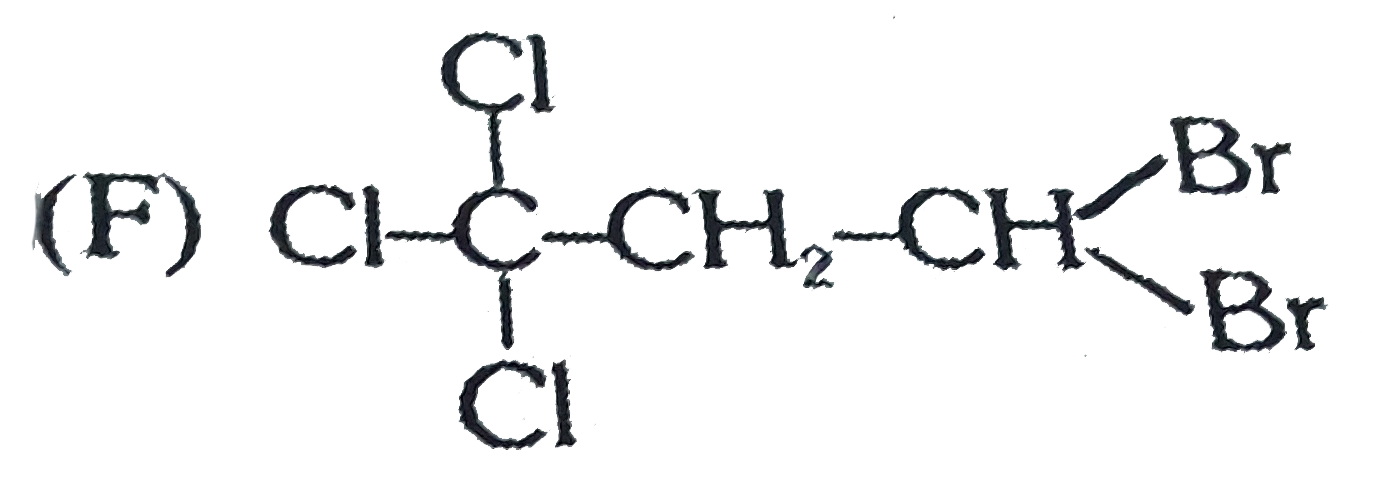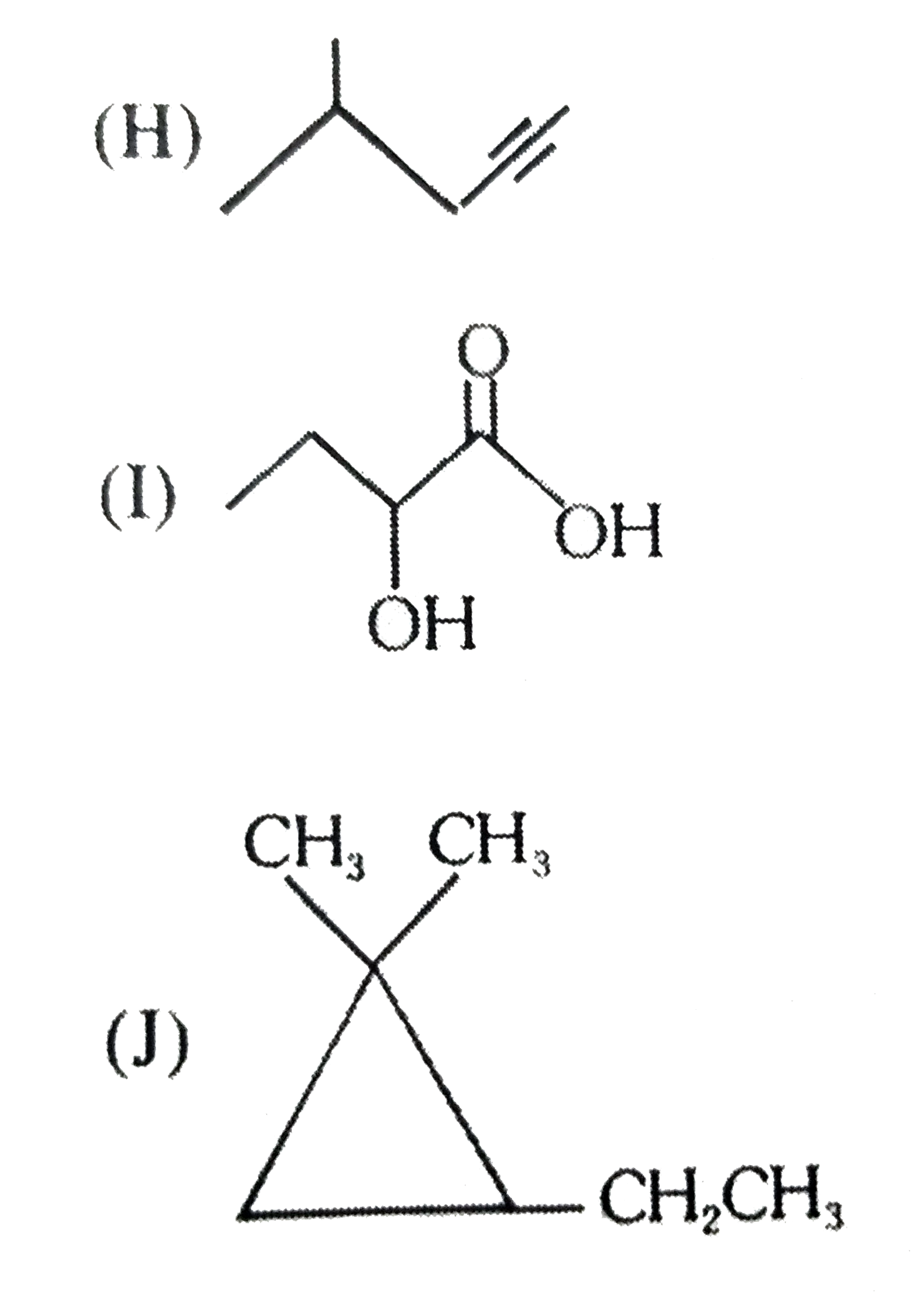HyderocarbonH2.→∣NiCH3−CH2−CH3

H3C−CH=CH2
HC≡C−CH3
All of these
The correct Answer is:D
To solve the problem, we need to identify the hydrocarbon that, when subjected to hydrogenation in the presence of nickel (Ni), yields propane (CH₃-CH₂-CH₃).
1. Understanding Hydrogenation:
- Hydrogenation is a chemical reaction that involves the addition of hydrogen (H₂) to a compound. It typically occurs in the presence of a catalyst, such as nickel (Ni), palladium (Pd), or platinum (Pt).
- This reaction is commonly used to convert unsaturated hydrocarbons (alkenes or alkynes) into saturated hydrocarbons (alkanes).
2. Identifying Propane:
- The product of the hydrogenation reaction is propane, which has the molecular formula C₃H₈ and the structural formula CH₃-CH₂-CH₃.
3. Finding the Starting Hydrocarbon:
- To produce propane through hydrogenation, we need to start with a hydrocarbon that has either a double bond (alkene) or a triple bond (alkyne).
- The reaction will convert the double or triple bond into a single bond while adding hydrogen atoms.
4. Analyzing Possible Hydrocarbons:
- Let's analyze the options:
- Option A: An alkene such as propene (CH₃-CH=CH₂) will yield propane upon hydrogenation.
- Option B: An alkyne such as propyne (CH₃-C≡CH) will also yield propane upon hydrogenation.
- Option C: Any other alkene or alkyne that can be hydrogenated to form propane.
5. Conclusion:
- Since all the hydrocarbons that contain double or triple bonds can be hydrogenated to form propane, the correct answer is that all of these hydrocarbons can produce propane upon hydrogenation.
Final Answer:
The correct option is D: All of these.
---
- Hydrogenation is a chemical reaction that involves the addition of hydrogen (H₂) to a compound. It typically occurs in the presence of a catalyst, such as nickel (Ni), palladium (Pd), or platinum (Pt).
- This reaction is commonly used to convert unsaturated hydrocarbons (alkenes or alkynes) into saturated hydrocarbons (alkanes).
- The product of the hydrogenation reaction is propane, which has the molecular formula C₃H₈ and the structural formula CH₃-CH₂-CH₃.
- To produce propane through hydrogenation, we need to start with a hydrocarbon that has either a double bond (alkene) or a triple bond (alkyne).
- The reaction will convert the double or triple bond into a single bond while adding hydrogen atoms.
- Let's analyze the options:
- Option A: An alkene such as propene (CH₃-CH=CH₂) will yield propane upon hydrogenation.
- Option B: An alkyne such as propyne (CH₃-C≡CH) will also yield propane upon hydrogenation.
- Option C: Any other alkene or alkyne that can be hydrogenated to form propane.
- Since all the hydrocarbons that contain double or triple bonds can be hydrogenated to form propane, the correct answer is that all of these hydrocarbons can produce propane upon hydrogenation.
The correct option is D: All of these.
Topper's Solved these Questions
Similar Questions
Give the IUPAC name of the compound
CH3−CH2−CH2−H∣C∣CH2−CH3−CH2−CH2−CH3
View SolutionWrite down the IUPAC names of the following compounds :-
(A) CH3−CH∣C2H5−CH3∣CH−CH∣OH−CH3
(B) CH2=CH−CH∣CH2−OH−CH2−CN
(C) CH3−CH2CH3∣C∣CH3−C(CH3)3
(D) CH3−CH∣CN−CN∣CH−CH2−CH3
(E) CH2=CH−CH∣C≡C−CH3−CH2−CHO
(F)
(G) CH2=CH−CH∣CH3−C≡CH

View Solution
Knowledge Check
The reaction CH3−CH3∣C∣CH3−ONa+CH3CH2Cl−−−−→−NaClCH3−CH3∣C∣CH3−O−CH2−CH3
is calledAWilliamson continuous etherification processBGatterman - Koch reactionCEtard reactionDWilliamson SynthesisIn this reaction CH3−CH3∣C∣Br−CH2−CH3C2H5ONa−−−−−→Alcoholic
A2-ethoxy-2-methylbutane is the major product in the presence of ethoxide ionBmixture of 2-methyl-2-butene and 2-methyl 1-butene is formed in the presence of ethoxide ionCboth are correctDnone of these.IUPAC name of CH3−CH3∣C∣OH−CH2−CH3
A2-Methyl-butan-2-olB2-Methyl-butan-1-olC3-Methyl-butan-1-olDNone of these
Give the IUPAC name of the compound
CH3−CH2−CH3∣C∣CH3−C∣CH2−CH3H−CH(CH3)2
View SolutionIn the given reaction CH3−CH3∣C∣CH3−CH2−BrΔ−−→[X]
[X] will be
View SolutionPredict the product of the reaction CH3−CH3∣C∣H−H∣C∣Cl−CH2−CH=CH2alc.KOH−−−−−→
View SolutionThe IUPAC name of
CH3−CH∣OH−CH2−CH2−CH2−Br∣C∣Br−CH3
View SolutionThe give reaction
H−CH2−CH3∣C∣CH3−Br ΘOH−−−−−→HO−CH2−CH3∣C∣CH3−H
Is an example of
View Solution
